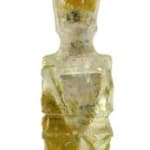Islamic Glass Molar Flask, 800 CE - 1000 CE
Glass
GF.0161
The shoulder of this translucent yellowish colourless “molar” flask is angular. The base of the neck was grooved, the neck is multisided and flared at the top. The grooved decoration...
The shoulder of this translucent yellowish colourless “molar” flask is angular. The base of the neck was grooved, the neck is multisided and flared at the top. The grooved decoration consists of a horizontal band, and V-shaped elements at each corner on the body. The feet of the vessel are short and wedge-shaped.
The “molar” bottle is a characteristic example of cut Islamic glass. Its name derives from the four wedge-shaped feet, which resemble the root of a molar tooth. It is believed that such bottles were produced in Egypt and were distributed throughout the Islamic world as perfume containers. Some scholars consider them imitations of the bone-doll amulets of the Late Coptic period. Similar bottles were also fashioned from metal and ivory.
Flasks such as this one were common in the ninth and tenth centuries CE, but thereafter their production ceased. (LK)
The “molar” bottle is a characteristic example of cut Islamic glass. Its name derives from the four wedge-shaped feet, which resemble the root of a molar tooth. It is believed that such bottles were produced in Egypt and were distributed throughout the Islamic world as perfume containers. Some scholars consider them imitations of the bone-doll amulets of the Late Coptic period. Similar bottles were also fashioned from metal and ivory.
Flasks such as this one were common in the ninth and tenth centuries CE, but thereafter their production ceased. (LK)



